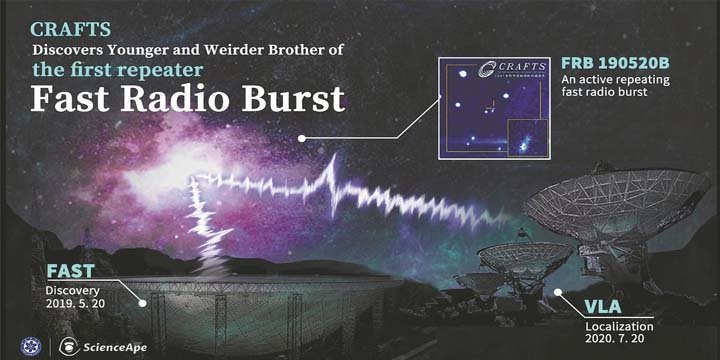FAST RADIO BURST
WHY IN NEWS ?
- Astronomers have detected an intense flash of radio waves coming from the oldest-known instance of a phenomenon called a fast radio burst.
MORE ABOUT THE NEWS:
- The burst in less than a millisecond unleashed the amount of energy our sun emits in three decades.
- It was detected using the Australian SKA Pathfinder, a radio telescope in the state of Western Australia.
- Its location was pinpointed by the European Southern Observatory’s Very Large Telescope in Chile, one of the most powerful optical telescopes.
- Until now, the oldest-known such burst dated to 5 billion years ago, making this one 3 billion years older. The universe is about 13.8 billion years old.
ABOUT RADIO BURST:
- A fast radio burst (FRB) is a pulse of radio-frequency electromagnetic radiation.
- It lasts a small fraction of a second but outshines most other sources of radio waves in the universe.
- Radio waves have the longest wavelengths in the electromagnetic spectrum.
- The radio waves in FRBs are similar to those used in microwave ovens.
- The amount of energy in this FRB is the equivalent to microwaving a bowl of popcorn twice the size of the sun.
SOURCES OF FAST RADIO BURST:
- The most likely source is a hyper-magnetized neutron star, called a magnetar.
- These stars are stellar corpses the mass of the sun but only the size of a small city.
- They are some of the most extreme objects in the universe, which you would need to produce such extreme bursts.
- There are more energetic events in the universe, associated with stellar explosions or a black hole shredding a star apart.
- But FRBs are unique in that they produce all their energy in radio waves, with nothing seen in other bands – optical light or X-rays for example – and that the signals are so short.
SIGNIFICANCE OF THESE BURSTS:
- The researchers said that studying these bursts also can help to detect and measure the immense amount of matter believed to populate the expanses of space between galaxies.
- As these radio waves zip though the cosmos, they can flag the presence of this intergalactic plasma – gas so hot that some or all its atoms are split into the subatomic particles electrons and ions.
Syllabus: Prelims; CURRENT AFFAIRS




